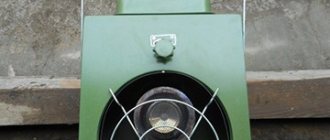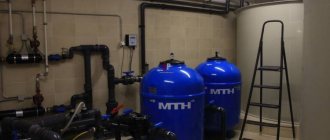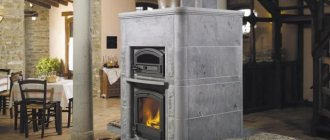Author: Yuriy Fedorovich Kolesnikov, thermal power engineer
Diesel fuel (solar oil, diesel fuel, diesel fuel; simply diesel) has a high calorific value to cost ratio and transportability, and in terms of fire hazard it is closer to vegetable oils and heavy petroleum products than to light ones. Therefore, diesel fuel stoves are widely used wherever there is no local fuel or opportunities for its procurement. Another advantage of a diesel stove (diesel stove) is that it quickly reaches full speed without supercharging. In fact, a diesel stove is the only energy-independent means to quickly warm up an uninsulated, very cold room.
Industrial diesel fuel furnaces
However, making a fairly safe diesel stove with your own hands requires much more care and deeper knowledge of the matter than using heavy liquid fuel, for example, during testing. In terms of volatility (evaporation), diesel fuel is still closer to light petroleum products. Under no circumstances should you burn diesel in a pressure-free burner (simply in a bath) with the air supply regulated by a throttle, like oil: the fuel may boil over the entire mass and result in an explosion.
The authors of popular RuNet guides on this topic seem to be more knowledgeable about copying from each other than about heating engineering. The absurdity of the errors reaches a kind of “medical burner” (???). It is possible (but not necessary) to make a feeding reservoir for a furnace with a dropper from a medical heating pad. But if anyone knows what a “medical burner” is, it’s not doctors. This article describes what is possible and how to properly make a diesel fuel stove with your own hands.
Note: non-volatile stoves that can quickly reach maximum mode and heat uninsulated rooms are most often called miracle stoves. Another meaning of the name miracle stove is multi-fuel, incl. on solid, liquid fuel and gas. Another one is an autonomous furnace using diesel fuel, waste fuel and, possibly, kerosene. In this publication, depending on the context, it is possible to use the term “miracle oven” in any of the indicated senses.
Diesel fuel stove
A stove using diesel fuel (diesel fuel) is essentially the same kerosene gas, only modified and having a modern appearance.
It justifies its name due to its small size, simplicity of design and operation, in contrast to, for example, a homemade miracle furnace for mining, which has a rather complex configuration.
This is a heating device designed for heating or heating a country house, industrial premises, stalls. The device is universal; it can also be used for cooking or boiling water.
The heater, powered by diesel fuel, is suitable for installation in your garage or workshop. In a house, even a country house, its use is not recommended - when igniting and extinguishing the combustion, fuel vapors and an unpleasant odor will inevitably enter the room.
The compact, self-contained unit is also used as an emergency heat source and for cooking during power outages, and food can be cooked by installing a stove outside.
In addition to compactness and light weight, a diesel fuel stove is characterized by cost-effectiveness and high efficiency. The fuel burns with virtually no emissions into the atmosphere and with high thermal energy output. This makes the liquid fuel unit more practical than a classic wood-burning stove.
During operation, you should carefully monitor compliance with safety rules - flammable objects should not be placed near the operating stove.
The list of objects that can be effectively heated with such a stove:
- greenhouses, greenhouses;
- basements, basements;
- country houses, similar structures on the site;
- garages, utility rooms, workshops, tents, cabins;
- Living spaces.
What objects can be heated by a miracle stove?
Modern stoves using diesel fuel as fuel, regardless of their shape and design, are capable of heating various rooms. They successfully cope with the task of maintaining comfortable temperature conditions in the following buildings:
- country houses that do not have communications;
- separate rooms of residential suburban buildings;
- additional country buildings (sheds, outbuildings);
- extensions, basements, basements;
- garages, workshops;
- free-standing greenhouses and greenhouses;
- They can be used to heat individual tents and campsites.
Main types of diesel fuel stoves
There are several main types of diesel stoves:
- Mini oven with wick.
Such heating devices can be purchased at the store. The design of the furnace consists of two main parts - a fuel tank and an open reservoir. The vessels are interconnected, and the fuel supply is controlled using a special valve.
Another essential element of a mini-stove is a wick, the tip of which is immersed in a vessel with fuel. The diesel fuel supply is adjusted thanks to a special valve.
After turning the valve, the valve between the communicating vessels opens, thereby saturating the wick with the flammable mixture. In the same way, the device turns off, cutting off the fuel supply.
This stove is lit manually. A match or lighter is suitable for this. It is worth lighting the wick a couple of minutes after opening the valve. You must also wait 10 minutes for the oven to warm up. Afterwards, the autonomous diesel stove will work independently.
The diesel fuel mini-oven turns off 5 minutes after you turn off the valve.
- Heat gun.
Heating units of this type are designed to heat large areas (from 30 m²) in all weather conditions. A diesel stove is a warm air blower in the form of a pipe mounted on wheels for ease of movement.
A turbine built at the end of this pipe is responsible for creating the air flow. The burner for the stove, which burns diesel fuel, is placed inside the combustion chamber and is washed with air from all sides.
There are 2 types of heat guns:
- Directly heated. This means that the air passing through the pipe is heated by the walls of the chamber and mixed with the combustion products coming out from there, and then the mixture of gases enters the room. The heater is very efficient, but is not suitable for use in confined spaces.
With indirect heating. The design is similar to the first, but the exhaust gases are not mixed with the air flow and are directed through a separate channel into the chimney, as shown in the diagram. The heater loses efficiency, since part of the heat is lost along with combustion products, but it is absolutely safe and is capable of heating living spaces.
You can make a direct combustion stove yourself. Such a unit will work due to natural air draft.
To create a direct combustion furnace, only three structural elements are needed - two metal tanks and a pipe. Containers can be either square or cylindrical.
The lower tank serves as a container for diesel fuel. It is necessary to attach several legs to it for the stability of the structure. The tank is no more than half filled with liquid fuel. You need to make a small hole in the lid with a damper through which you can regulate the air supply.
A pipe must be connected to the lower tank. This is the so-called afterburner. In it, the remaining fuel is mixed with secondary air.
The pipe is connected to the upper tank. The container must be equipped with a partition inside, behind which a hole will be made for the smoke to escape.
The disadvantage of such a stove is its high fuel consumption. An hour of heating can take up to 2 liters of diesel fuel. Like any homemade heating device, a direct combustion stove can catch fire, so it should not be left unattended.
Unlike a direct combustion stove, a dropper stove is a fairly safe design. True, it is not as popular, because it is quite difficult to design it yourself.
For the base of the furnace, a waste gas cylinder or a large steel pipe is usually used. The combustion process of diesel fuel occurs in a special bowl, which must be installed at the bottom of the stove base.
A small pipe that needs to be inserted vertically into the base of the structure is suitable as an afterburner. At the base of the afterburner, in the place that comes into contact with the bottom, it is necessary to make 9 slits several millimeters in size.
The fuel container is located separately from the dropper stove above the entire structure. The fuel flows through a small tube into the afterburner. The tube should be made of copper. It is necessary to bend it between the top of the afterburner and the container with diesel fuel at an angle of 90 degrees. A rag should be used as a wick. It is necessary to make a small door in the structure through which flammable material can be placed.
Furnace design:
- body made of heat-resistant steel, powder-coated (the coating is also heat-resistant); removable fuel tank, equipped with a valve;
reflector (increases heat transfer efficiency);
The metal casing contains an open reservoir and a fuel tank connected to it according to the principle of communicating vessels. To prevent diesel fuel from flowing out of the tank uncontrollably, the outlet pipe is equipped with a special valve.
A simple and reliable burner for a stove running on diesel fuel was precisely what she inherited from kerosene gas. It is a wick, the lower part of which is immersed in a tank with liquid fuel.
If you open the valve and supply fuel to the working container, the wick wound on a cylindrical base will quickly absorb it. After some time, the miracle diesel stove is ignited manually, after which you still need to wait until it warms up and reaches operating mode. The power is regulated by a valve, and with its help the heater is turned off.
The metal reflector is located on the body, which is powder coated. It is thanks to the reflector that the room is effectively heated. The burner is located in the center of the miracle stove, and the fuel flows by gravity from the fuel tank located on the rear panel.
Using the adjusting screw, the required room heating temperature is set. This is the general design of a diesel stove, but it may vary slightly between models from different manufacturers. Heat-resistant steel is used to make the stove.
The weight of the stove can be 10 kg, which allows it to be moved, depending on the need, to another room. Dimensions: height from 3500 to 6000 mm, depth and width from 2500 to 4000 mm. Such light weight and small dimensions allow it to be moved with the strength of one adult.
Reviews
Consumers love miracle liquid fuel stoves. People find them practical and convenient. Used to heat garages, barns, and other household items. buildings
They note, however, that using a stove as a stove is not effective; cooking “is the same as using a radiator.” Food heats up much faster if you light a fire or use a burner with an open flame while camping. Another note is about the fuel supply control system.
Penza Solar Gases use a primitive, very inert method. In addition, the tap is not equipped with seals; air is sucked in, which leads to combustion instability. For example, Japanese liquid fuel stoves operating on the same principle are much better designed and easier to regulate.
Operating principle of the furnace
The operating principle of a diesel fuel stove is as follows.
- From the fuel tank, diesel fuel flows by gravity into the wick bowl. The amount of incoming fuel is regulated.
- In the wick bowl, when heated, the fuel turns into a gaseous mixture. The mixture is burned in a combustion chamber.
- The design of the furnace provides for such an arrangement of elements in the combustion chamber that ensures uniform combustion of fuel.
- A special element and spiral located in the upper part of the combustion chamber can heat up to 800 degrees.
The oven has a number of warnings:
- to avoid a pungent odor indoors, it is better to ignite the miracle stove outdoors;
- due to the same smell, it is not recommended to use the product for heating residential premises on an ongoing basis;
- During intensive use, it is necessary to clean the burner and change the wicks frequently.
A modern diesel fuel stove is, first of all, a safe and inexpensive device to maintain, since in the combustion chamber all combustible elements burn completely.
Precautionary measures
A heating device of this type cannot be used in bedrooms during rest periods, or in places where there is no or very poor ventilation! Diesel fuel emits acrid smoke, which can enter the room during ignition and extinguishing. The air exchange volume should be 20 m3 per hour or more.
At the same time, this should not be a drafty area.
Stove "Solyarogas"
Do not place the stove close to walls, furniture or other objects, especially if they are made of flammable materials. The distance around the device is at least 50 cm on each side.
Do not allow any liquids, including water, to come into contact with a burning stove.
It is not recommended to experiment with fuel. The manufacturer has already done this at the enterprise.
The results of such experiments can be read in the instructions, which list all brands of fuel compatible with this model.
Advantages and disadvantages of the oven
Advantages of the stove:
- absence of harmful gases and fumes during operation;
- safety - a working stove can be left unattended;
- low fuel consumption during operation (due to high density);
- efficiency;
- the possibility of adding biological fuel (vegetable oil, for example) to diesel fuel; ease of transportation;
- Possibility of using the top for cooking.
There are not many disadvantages - the cost of diesel fuel directly depends on world prices for crude oil. If you plan to build a diesel stove with your own hands, then the principle of its operation will be similar to that described above. But first, a little about fire safety.
Service
A diesel stove produces a lot of ash and soot. If you allow a layer of at least 2 mm, you can get increased fuel consumption by 10%. Therefore, there is a need for periodic cleaning.
And special attention in diesel heating devices is paid to the burner. When servicing, you should clean the divider and nozzles from carbon deposits. The frequency of such heating appliance servicing is determined by the quality of the fuel: the worse it is, the more often
The best option is once every 6 months
The frequency of such servicing of the heating device is determined by the quality of the fuel: the worse it is, the more often. The best option is once every 6 months.
Diesel boiler in action
You should not clean a diesel stove with your own hands, as this can lead to damage to the heating equipment. Trying on your own can be dangerous to your health.
Timely and qualified service of diesel heating equipment is a guarantee of its long-lasting and trouble-free operation.
Cleaning a diesel boiler
Recommendations for choosing a stove
- Of all the diesel stoves, only one is clearly suitable for heating residential premises - an indirect heating heat gun. Heating devices of the “Solarogas” type can be used as a temporary option if the room has ventilation.
- For a garage, box or cottage, it is better to make drip heaters with your own hands. Despite its popularity, we cannot advise you on a homemade miracle stove. This unit is too dangerous and has burned down more than one garage during its existence.
- A diesel heat gun is the only right solution when you need to heat a large area in a building where there are no other energy sources.
- If a drip-type stove is converted into a boiler and connected to a water heating system, then it can be used to heat a residential building. The heat source is removed to an extension or a separate building, where diesel smells will not bother anyone.
- It must be understood that all liquid fuel heaters require periodic cleaning of soot, which abundantly covers the internal surfaces of the combustion chambers and smoke channels. The exception is a factory mini-stove using diesel fuel, where you will have to change the burnt-out wicks.
Alternatives to gas heating
As I already mentioned, gas heating is the most convenient for permanent residences; gasification of a home is the ultimate dream. However, the total cost of gasifying a home forces us to look for an alternative to gas.
Electricity
Electricity itself is an excellent alternative to gas, if only it weren’t so expensive. Practice shows that over 7 months of the heating season, using only electric heating, you will have to spend 50-60 thousand rubles, and this is with a good setup of the heating boiler.
Using electricity, you can heat your house using:
- Electric heating boiler (100 meters of house = 10 kW boiler).
- Electric convectors (cheap installation, but requires new wiring).
- Film infrared heating (rarely used as the main heating due to the high cost of installation and operation).
In addition to electricity, alternatives to gas can be:
Diesel fuel. There are a lot of disadvantages: expensive equipment, you need a special place for the container, you need to constantly replenish fuel. Cost of diesel fuel: 2-3 rubles per 1 kW of heat.
Firewood. Wood heating is not easy. On the one hand, they are accessible. If you prepare them yourself, they are quite cheap. This is probably why all of rural Finland is heated with wood. In Russia, the cost of purchased firewood is slightly more expensive than gas, but cheaper than all other types of fuel. Gas - 20-30 kopecks per 1 kW, firewood - 70 kopecks, coal 1.3 -1.5 rubles, electricity - 3±1 ruble per 1 kW.
Sun. If you don't live in a sunny area, the sun can be considered a source of heating for your home. Typically, solar collectors can only act as an additional source, for example, of charging the batteries of an uninterruptible power supply system or gas boilers.
BIO fuel. Today, BIO fuel is difficult to consider as a real alternative to other heat sources.
DIY diesel stove
Today, the main problem of summer cottages remote from big cities is the lack of sufficient energy resources.
Sometimes people find it difficult to even find dry wood, while connection to substations is planned in the very distant future. In such cases, the best option may be a homemade diesel stove. It is used mainly in those rooms where the use of other types of heating is impossible for one reason or another. The main thing is that these rooms are well ventilated.
The good thing about a homemade device is that the owner of a room that needs to be heated, knowing his own needs, can make a stove that ideally meets the expected operating conditions. It will be both more efficient and more economical.
Keeping in mind safety requirements, a homemade diesel stove can, in principle, be built under one of the following schemes:
- Double-circuit gas-air;
- Wick;
- Drip.
Dripper stove made from a gas cylinder
A used gas (carbon or oxygen) cylinder can serve as the main one for making a furnace.
The fuel will flow by gravity, and forced air supply is not needed with this design. Heating of the cylinder to fire hazardous temperatures must be prevented by setting the height of the device contour according to the height of the combustion source located inside.
Pay attention to the thickness of the walls of the cylinder. We need flammable fuel vapors to form. If the walls are thicker, the temperature required for boiling will not be reached.
On the street, you should drain the condensation from the container and rinse the container a couple of times with water so that there is no odorant left in it. Then it is filled with water to the top and buried in the ground for stability. Use a grinder to cut off the top part of the cylinder with the valve.
Attention should be paid to the fact that the chimney must be vertical without angles or slopes. The length of the chimney pipe itself should not be less than 4 meters.
Mining can also be poured into this structure, but only after its preliminary cleaning. If the oil is unrefined, it may contain water or alcohol. Then when heated there is a danger of explosion and fire.
Fuel is poured into 2/3 of the tank. A lit sheet of paper is placed on top of the diesel fuel and the stove lid is closed. Spontaneous combustion of vapors will occur after the temperature rises. You cannot add fuel to a working stove; you cannot use gasoline or kerosene in this model either.
Step-by-step instruction:
- We free the container from condensate and rinse it thoroughly. Then we bury it in the ground and cut off the top of the container along with the valve.
- Now we have a place for the lid. The legs should be welded to the lower part of the structure. For this we use steel corners.
- Next, cut a hole in the lid for the pipe; the size should be equal to the diameter of the chimney. We weld the pipe into the hole, making sure the seams are tight. We weld the chimney pipe to the horizontal pipe.
- We cut out a square for the blower at the bottom of the structure and install a door to regulate the air.
- Now we prepare the container for fuel. This will be a pipe (70x140 mm) and will be placed at the bottom of the gallon. We weld a piece of the pipe from below, making sure it is tight.
- We prepare a lid with two holes from a sheet of metal. Moreover, we place them in the center and along the edge. We immediately weld a pipe of equal diameter (100 mm) to the central tube. We install a movable flap (diameter 50 mm) to the second hole for filling fuel.
- We install the chimney vertically without any tilting. We choose its length 4 meters, more is possible.
- Pour fuel into the third part of the cylinder. We light a piece of paper and place it on top of the diesel fuel, and the stove lid closes. As the temperature increases, the vapors will ignite.
Steel sheet furnace
A device made of steel sheets is very popular.
It is compact (70x50x35 cm, not counting the chimney) and quite light, because... weighs only 27 kg. You can cook on it, water heating is connected to it, and it is not afraid of frost.
Briefly, it looks like two large cans or disks connected by a pipe with many holes and a combustion pipe at the top.
The device consists of two containers connected by a large diameter pipe (wick bowl) with rows of holes for air intake and smoke exhaust.
Kerosene or diesel fuel from the fuel chamber enters the wick container by gravity. There the fuel is heated and a gaseous mixture is obtained. It goes into the combustion chamber and burns there.
A spiral is placed in its upper part, it acts as a heating element and heats up to 800°C, combustion waste is removed through the chimney.
A home-made device can be compact in size and has a high level of safety.
It is very economical: the fuel mixture and flammable compounds burn completely.
You will need metal sheets with a thickness of 5 mm or more. The pipe has 2 elbows that fit inside each other and is located far from the door.
The lower container serves as a firebox and at the same time a fuel tank; it has a hole for filling fuel. The average such device holds about 2–12 liters of diesel fuel.
Self-production
A self-assembled diesel fuel burner is calculated exactly for the requirements of the garage space. Efficiency and cost-effectiveness are increased. The structure is assembled using three technologies:
- device from a gas cylinder;
- drip type heater;
- heating device made of metal sheets.
Before starting work, get acquainted with the design options and choose the optimal one.
- LiveJournal
- Blogger
Requirements for a diesel boiler room in the house
Installing a diesel boiler in a house is a complex technical process that requires qualified assistance. When connecting, take into account current regulatory requirements and fire safety rules. Setup and maintenance are carried out using special computer software.
The organization of heating in a private house with a diesel boiler is carried out in compliance with the following conditions:
- The room for the boiler is selected from technical rooms with sufficient area, lighting, and ventilation.
- Placement of diesel boiler houses in residential country houses is carried out on a non-combustible basis. Walls and floors are finished using non-combustible building materials: ceramic tiles, plaster.
- Automation – maintaining the temperature in the house is carried out automatically. Human participation in the operation of the heat generator is reduced to a minimum. It is mandatory to install an automatic safety system that turns off the operation of the boiler in the event of an emergency.
- Ventilation in the boiler room is provided through channels with natural and forced air supply and exhaust. The cross-section of the ventilation duct is calculated based on triple air exchange within an hour.
- Diesel fuel storage is installed in a separate building. In the boiler room, it is allowed to store a reserve tank with a maximum capacity of no more than 3-5 m³.
Correct installation of a diesel boiler in a residential private house is based on an understanding of work processes. The burner device creates strong noise interference, therefore, soundproofing measures are carried out in the boiler room.
Additionally, a UPS and a stabilizer are installed to ensure system operation even during power surges or power outages.
Advantages and disadvantages of household diesel boilers
Reviews of diesel heating boilers for private houses and cottages point to the same problem. The domestic consumer, even if he reads the operating instructions, adjusts the operation of the boiler to his needs, violating the manufacturer’s recommendations, which is the main cause of malfunctions.
The performance of boiler equipment depends on proper operation, from accurately adjusted settings to the need for regular maintenance. If you heat your house correctly with a diesel boiler, high rates of efficiency and heat transfer are observed. Any violations lead to excessive fuel consumption.
The disadvantages of heaters are:
- Noise of boilers - as a rule, the noise is not heard if the passage to the boiler room is closed by a door. It is not recommended to install a diesel boiler in the kitchen or any room adjacent to living rooms.
- Maintenance cost - you will need to regularly clean the heat exchanger and chimney pipe from accumulated soot. When switching to another type of liquid fuel, as well as before the start of the heating season, the burner needs to be adjusted. The optimal solution that allows you to save money is to sign a permanent service agreement.
The advantages of boilers are low installation costs, quick commissioning, and no need to obtain permits or approvals.
The most economical boiler is one that is installed and operated in accordance with the manufacturer's recommendations. After installation and connection, a company representative will provide instructions on how to use the heat generator.
Operating experience shows that following the recommendations is the best way to extend the life of the boiler, ensure maximum heat transfer and comfortable heating of residential premises.
Calculation of power and temperature of a warm water floor
Chimney
The chimney represents the main part of the heat generators. Installation of a heating system is impossible without this carbon monoxide combustion chamber. The chimney in a residential complex can be internal or external. An external chimney is a pipe-in-pipe installation. Chimneys can be individual - when one chimney is installed on several heating units. With the help of a specialist, the selection and calculation of the chimney is carried out. Improper installation of the chimney can lead to upcoming repair work (if the installation took place without taking into account the shape of the roof, then wind gets into the chimney and there is a possibility of extinguishing the flame)
It is important to know that the width of the chimney pipe should be greater than the width of the diesel unit
Any fuel appliance, gas or diesel, or wood-burning, diesel-gas boiler, chimney must be made of steel. Due to the evaporation of aggressive acids, a chimney made of a different material will need repair very soon. And carbon monoxide particles entering the house through cracks will cause harm to health. Therefore, installing a steel chimney is the most reliable option both from a repair perspective and from a health perspective.
Quite recently, chimneys of an unusual configuration have appeared on the market; they are called insulated chimney ventilation systems. Installation is carried out by specialists, because the system is complex, multi-variant and universal. The price for such an insulated chimney is at the same level as the price for a stainless steel chimney. Such chimneys are very resistant to acids and will not require repair work.
Review of kerosene heaters from popular manufacturers
There are a large number of different models of kerosene heaters on sale, which can be purchased at different prices. To make the right choice, it is advisable to focus on the most popular models that have successfully proven themselves among consumers.
- Kerosene heater Kerona. The Keron model is a compact design that can be successfully used for heating residential or technical premises. The structure is designed in such a way that it can also successfully heat tents without the risk of fire. Fire safety is ensured by the fact that special safety grilles are installed on the device, on which it is impossible to get burned. Most models have such protective components installed. Many models are also equipped with a kind of protection system that prevents fuel from leaking even if the equipment tilts to the side. Most heaters are equipped with an electric ignition system, so there is no need to use matches or a lighter. To purchase a good model, you must also ensure that the device has an automatic fire extinguishing system installed in the event that the device tips over. The WKH-2310 model is equipped with this function.
- Kerosene heater "Umnitsa". The model can be used to heat greenhouses, garages or living spaces. Also suitable for heating small industrial premises. The equipment is often purchased by fishermen, hunters and hikers. A distinctive feature of the model is that you can heat or cook your own food on it. The operating time of a kerosene heater is approximately 16 hours.
- Kerosene heater "Comfort". The equipment, like the previous one, can be used for heating greenhouses, garages or non-residential premises. Fishermen and hunters often purchase this model for their leisure time. The equipment can operate without interruption for approximately 12 hours.
- Toyotomi. This is a Japanese kerosene heater that can be used to heat residential premises, garages and small industrial facilities. A good security system is built into the equipment, as well as automatic ignition. There are models that can heat a room up to 70 square meters in size. It is important to note that it is not advisable to supplement the heater with additional devices yourself, otherwise there is a risk of damaging the device.
- Neoclima. These are Chinese manufacturers that produce very high-quality models of heating systems running on kerosene or diesel fuel. After refueling, you can use the equipment for an average of 14 hours. Most types of equipment also have automatic ignition, which is powered by a battery. These are good tent heaters.
How to use it correctly?
To light a diesel stove, you need to perform the following algorithm:
- place the device on a horizontal surface made of non-flammable material;
- install the wick into the burner block;
- remove the fuel tank, unscrew the valve and pour fuel into the inlet using a funnel;
- install the valve in place and secure the tank in its original position;
- unscrew the valve and wait until the wick is saturated with diesel fuel;
- on the front panel of the case, open the door and light the wick;
- when the flame rises above the grate, the screw should be tightened completely;
- when the flame dies out, the screw must be unscrewed again and the combustion adjusted to the desired intensity.
To completely turn off the diesel stove, the adjusting screw is tightened until it stops. If the device has not been used for a long time, then before ignition it is necessary to clean all parts and rub the reflective screen until shiny.
When operating such a heating device, it is important to strictly follow fire safety rules:
- do not use the miracle stove using diesel fuel in rooms with poor ventilation;
- do not install the device near objects made of flammable materials and furniture;
- refuel with fuel in accordance with the manufacturer’s recommendations;
- do not allow liquids to come into contact with the operating device;
- During operation, ensure constant supervision by an adult family member.
To ensure a higher level of safety in a garage where there are a lot of combustible, flammable substances, you need to stock up on several fire extinguishers weighing 5 kg.
Ignition
You should start igniting outside, and when it has already flared up, bring it indoors to avoid unpleasant odors. If the device is not used for a long time, you should first clean it thoroughly.
Important! The device must be installed horizontally and levelly to achieve uniform combustion of the wick.
Ignition step by step guide:
- Fill the removable tank with diesel fuel.
- Install a new filter into the burner.
- Replace the burner, as well as the removable tank.
- Unscrew the valve to allow fuel to flow to the wick.
- Open the front door and light a heating pad from underneath.
- As soon as the fuel ignites and the flame is above the grate, the valve should be fully tightened.
- When the fire begins to die down, open the valve and set it to the desired intensity.
To turn off the device, simply close the valve completely.
If you can't get an even blue flame across the entire wick, you may have one of the following problems:
- the device is installed on an uneven surface;
- the burner cylinder did not have time to warm up;
- The wick is worn out.
Advice! To extend the life of the wick, it should be washed in kerosene from time to time. In addition, you can turn it over or cut off the burnt edge.
Safety rules come first
The do-it-yourself diesel fuel stove that we are going to make is perfect not only for the garage, but also for basements, for various buildings on a summer cottage, and especially for greenhouses.
It seems that order in the garage is everyone's personal matter. But, having realized the danger of a fire, which can damage not only your property, but also neighboring garages, you come to the conclusion - it’s better to protect yourself
The garage is a special place. Firstly, it stores valuable property - a car and many other things, the true importance of which can only be understood by mechanic enthusiasts. Secondly, flammable substances may always be present here. Therefore, even before starting work, it is necessary to know the fire safety rules. After all, we are going to create a source of increased danger.
- The unit should not be installed in areas prone to drafts.
- The finished structure should not be placed where flammable objects could get inside the stove.
- Despite the limited space in the garage, you need to install the heater so that there is at least half a meter of free space around it.
- Avoid the presence of flammable substances and rags soaked in waste nearby.
A carbon dioxide fire extinguisher will also help protect yourself, but it’s better to take two such devices to be sure. The fire extinguisher must be automatic and non-volatile. Estimate that the volume of gas it produces is at least 1.5 times the cubic capacity of the garage. Focus on 5 kg.
There are quite a lot of fire extinguishers produced, they are designed for a variety of purposes. For a garage, choose carbon dioxide, automatic and non-volatile, or better yet two
If you simply open the valve of such a fire extinguisher, nothing will happen: a special membrane will reliably protect the contents of the cylinder. If it is heated to approximately 70 degrees or higher, the membrane will unfold and be pierced by the tip, and the gas will begin to escape.











